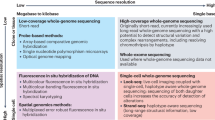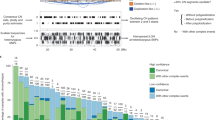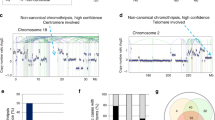Abstract
Next-generation sequencing of DNA from human tumors or individuals with developmental abnormalities has led to the discovery of a process we term chromoanagenesis, in which large numbers of complex rearrangements occur at one or a few chromosomal loci in a single catastrophic event. Two mechanisms underlie these rearrangements, both of which can be facilitated by a mitotic chromosome segregation error to produce a micronucleus containing the chromosome to undergo rearrangement. In the first, chromosome shattering (chromothripsis) is produced by mitotic entry before completion of DNA replication within the micronucleus, with a failure to disassemble the micronuclear envelope encapsulating the chromosomal fragments for random reassembly in the subsequent interphase. Alternatively, locally defective DNA replication initiates serial, microhomology-mediated template switching (chromoanasynthesis) that produces local rearrangements with altered gene copy numbers. Complex rearrangements are present in a broad spectrum of tumors and in individuals with congenital or developmental defects, highlighting the impact of chromoanagenesis on human disease.
This is a preview of subscription content, access via your institution
Access options
Subscribe to this journal
Receive 12 print issues and online access
$209.00 per year
only $17.42 per issue
Buy this article
- Purchase on Springer Link
- Instant access to full article PDF
Prices may be subject to local taxes which are calculated during checkout




Similar content being viewed by others
References
Mitelman, F., Johansson, B. & Mertens, F. The impact of translocations and gene fusions on cancer causation. Nat. Rev. Cancer 7, 233–245 (2007).
Stephens, P.J. et al. Complex landscapes of somatic rearrangement in human breast cancer genomes. Nature 462, 1005–1010 (2009).
Campbell, P.J. et al. Identification of somatically acquired rearrangements in cancer using genome-wide massively parallel paired-end sequencing. Nat. Genet. 40, 722–729 (2008).
Campbell, P.J. et al. The patterns and dynamics of genomic instability in metastatic pancreatic cancer. Nature 467, 1109–1113 (2010).
Stephens, P.J. et al. Massive genomic rearrangement acquired in a single catastrophic event during cancer development. Cell 144, 27–40 (2011).
Kloosterman, W.P. et al. Chromothripsis as a mechanism driving complex de novo structural rearrangements in the germline. Hum. Mol. Genet. 20, 1916–1924 (2011).
Chiang, C. et al. Complex reorganization and predominant non-homologous repair following chromosomal breakage in karyotypically balanced germline rearrangements and transgenic integration. Nat. Genet. 44, 390–397 (2012).
Liu, P. et al. Chromosome catastrophes involve replication mechanisms generating complex genomic rearrangements. Cell 146, 889–903 (2011).
Kloosterman, W.P. et al. Constitutional chromothripsis rearrangements involve clustered double-stranded DNA breaks and nonhomologous repair mechanisms. Cell Rep. 1, 648–655 (2012).
Eldredge, N. & Gould, S.J. Punctuated equilibria: an alternative to phyletic gradualism. Models in Paleobiol. 82, 82–115 (1972).
Chen, J.M., Ferec, C. & Cooper, D.N. Transient hypermutability, chromothripsis and replication-based mechanisms in the generation of concurrent clustered mutations. Mutat. Res. 750, 52–59 (2012).
Crasta, K. et al. DNA breaks and chromosome pulverization from errors in mitosis. Nature 482, 53–58 (2012).
Gordon, D.J., Resio, B. & Pellman, D. Causes and consequences of aneuploidy in cancer. Nat. Rev. Genet. 13, 189–203 (2012).
Holland, A.J. & Cleveland, D.W. Losing balance: the origin and impact of aneuploidy in cancer. EMBO Rep. 13, 501–514 (2012).
Lengauer, C., Kinzler, K.W. & Vogelstein, B. Genetic instability in colorectal cancers. Nature 386, 623–627 (1997).
Thompson, S.L. & Compton, D.A. Examining the link between chromosomal instability and aneuploidy in human cells. J. Cell Biol. 180, 665–672 (2008).
Gascoigne, K.E. & Taylor, S.S. Cancer cells display profound intra- and interline variation following prolonged exposure to antimitotic drugs. Cancer Cell 14, 111–122 (2008).
Hoffelder, D.R. et al. Resolution of anaphase bridges in cancer cells. Chromosoma 112, 389–397 (2004).
Terradas, M., Martin, M., Hernandez, L., Tusell, L. & Genesca, A. Nuclear envelope defects impede a proper response to micronuclear DNA lesions. Mutat. Res. 729, 35–40 (2012).
Terradas, M., Martin, M., Tusell, L. & Genesca, A. DNA lesions sequestered in micronuclei induce a local defective-damage response. DNA Repair (Amst.) 8, 1225–1234 (2009).
Rao, P.N. & Johnson, R.T. Mammalian cell fusion: studies on the regulation of DNA synthesis and mitosis. Nature 225, 159–164 (1970).
Johnson, R.T. & Rao, P.N. Mammalian cell fusion: induction of premature chromosome condensation in interphase nuclei. Nature 226, 717–722 (1970).
Sperling, K. & Rao, P.N. The phenomenon of premature chromosome condensation: its relevance to basic and applied research. Humangenetik 23, 235–258 (1974).
Meyerson, M. & Pellman, D. Cancer genomes evolve by pulverizing single chromosomes. Cell 144, 9–10 (2011).
Holland, A.J. & Cleveland, D.W. Boveri revisited: chromosomal instability, aneuploidy and tumorigenesis. Nat. Rev. Mol. Cell Biol. 10, 478–487 (2009).
Zhang, W., Peng, G., Lin, S.Y. & Zhang, P. DNA damage response is suppressed by the high cyclin-dependent kinase 1 activity in mitotic mammalian cells. J. Biol. Chem. 286, 35899–35905 (2011).
Janssen, A., van der Burg, M., Szuhai, K., Kops, G.J. & Medema, R.H. Chromosome segregation errors as a cause of DNA damage and structural chromosome aberrations. Science 333, 1895–1898 (2011).
Tubio, J.M. & Estivill, X. Cancer: When catastrophe strikes a cell. Nature 470, 476–477 (2011).
Tang, H.L. et al. Cell survival, DNA damage and oncogenic transformation following a transient and reversible apoptotic response. Mol. Biol. Cell 23, 2240–2252 (2012).
Stanulla, M., Wang, J., Chervinsky, D.S., Thandla, S. & Aplan, P.D. DNA cleavage within the MLL breakpoint cluster region is a specific event which occurs as part of higher-order chromatin fragmentation during the initial stages of apoptosis. Mol. Cell. Biol. 17, 4070–4079 (1997).
Stanulla, M., Chhalliyil, P., Wang, J., Jani-Sait, S.N. & Aplan, P.D. Mechanisms of MLL gene rearrangement: site-specific DNA cleavage within the breakpoint cluster region is independent of chromosomal context. Hum. Mol. Genet. 10, 2481–2491 (2001).
Terradas, M., Martin, M., Tusell, L. & Genesca, A. Genetic activities in micronuclei: is the DNA entrapped in micronuclei lost for the cell? Mutat. Res. 705, 60–67 (2010).
Rausch, T. et al. Genome sequencing of pediatric medulloblastoma links catastrophic DNA rearrangements with TP53 mutations. Cell 148, 59–71 (2012).
Kloosterman, W.P. et al. Chromothripsis is a common mechanism driving genomic rearrangements in primary and metastatic colorectal cancer. Genome Biol. 12, R103 (2011).
Lieber, M.R. The mechanism of double-strand DNA break repair by the nonhomologous DNA end-joining pathway. Annu. Rev. Biochem. 79, 181–211 (2010).
Lee, J.A., Carvalho, C.M. & Lupski, J.R.A. DNA replication mechanism for generating nonrecurrent rearrangements associated with genomic disorders. Cell 131, 1235–1247 (2007).
Hastings, P.J., Ira, G. & Lupski, J.R. A microhomology-mediated break-induced replication model for the origin of human copy number variation. PLoS Genet. 5, e1000327 (2009).
Bartkova, J. et al. Oncogene-induced senescence is part of the tumorigenesis barrier imposed by DNA damage checkpoints. Nature 444, 633–637 (2006).
Di Micco, R. et al. Oncogene-induced senescence is a DNA damage response triggered by DNA hyper-replication. Nature 444, 638–642 (2006).
Zhang, J. et al. The genetic basis of early T-cell precursor acute lymphoblastic leukaemia. Nature 481, 157–163 (2012).
Wu, C. et al. Poly-gene fusion transcripts and chromothripsis in prostate cancer. Genes Chromosom. Cancer doi:10.1002/gcc.21999 (2012).
Northcott, P.A. et al. Subgroup-specific structural variation across 1,000 medulloblastoma genomes. Nature 488, 49–56 (2012).
Magrangeas, F., Avet-Loiseau, H., Munshi, N.C. & Minvielle, S. Chromothripsis identifies a rare and aggressive entity among newly diagnosed multiple myeloma patients. Blood 118, 675–678 (2011).
Molenaar, J.J. et al. Sequencing of neuroblastoma identifies chromothripsis and defects in neuritogenesis genes. Nature 483, 589–593 (2012).
Wahl, G.M. The importance of circular DNA in mammalian gene amplification. Cancer Res. 49, 1333–1340 (1989).
Mao, J.H. et al. Fbxw7/Cdc4 is a p53-dependent, haploinsufficient tumour suppressor gene. Nature 432, 775–779 (2004).
Kemp, Z. et al. CDC4 mutations occur in a subset of colorectal cancers but are not predicted to cause loss of function and are not associated with chromosomal instability. Cancer Res. 65, 11361–11366 (2005).
Kastan, M.B. & Bartek, J. Cell-cycle checkpoints and cancer. Nature 432, 316–323 (2004).
Gerlinger, M. et al. Intratumor heterogeneity and branched evolution revealed by multiregion sequencing. N. Engl. J. Med. 366, 883–892 (2012).
Yap, T.A., Gerlinger, M., Futreal, P.A., Pusztai, L. & Swanton, C. Intratumor heterogeneity: seeing the wood for the trees. Sci. Transl. Med. 4, 127ps110 (2012).
Ganem, N.J., Godinho, S.A. & Pellman, D. A mechanism linking extra centrosomes to chromosomal instability. Nature 460, 278–282 (2009).
Silkworth, W.T., Nardi, I.K., Scholl, L.M. & Cimini, D. Multipolar spindle pole coalescence is a major source of kinetochore mis-attachment and chromosome mis-segregation in cancer cells. PLoS ONE 4, e6564 (2009).
Maher, C.A. & Wilson, R.K. Chromothripsis and human disease: piecing together the shattering process. Cell 148, 29–32 (2012).
Acknowledgements
We apologize to all whose work was not cited because of space restrictions. This work was supported by a grant (GM29513) from the US National Institutes of Health to D.W.C., who receives salary support from the Ludwig Institute for Cancer Research. A.J.H. is supported by a Leukemia & Lymphoma Society special fellowship.
Author information
Authors and Affiliations
Corresponding authors
Ethics declarations
Competing interests
The authors declare no competing financial interests.
Rights and permissions
About this article
Cite this article
Holland, A., Cleveland, D. Chromoanagenesis and cancer: mechanisms and consequences of localized, complex chromosomal rearrangements. Nat Med 18, 1630–1638 (2012). https://doi.org/10.1038/nm.2988
Received:
Accepted:
Published:
Issue Date:
DOI: https://doi.org/10.1038/nm.2988
This article is cited by
-
Breakpoints in complex chromosomal rearrangements correspond to transposase-accessible regions of DNA from mature sperm
Human Genetics (2023)
-
Gene amplifications and extrachromosomal circular DNAs: function and biogenesis
Molecular Biology Reports (2023)
-
Spectrum of stable and unstable rearrangements in lymphocytic chromosomes investigated in Bhopal population 30 years post MIC disaster amid co-exposure to lifestyle, living, and occupational hazards
Environmental Science and Pollution Research (2023)
-
Approximation algorithms for sorting by k-cuts on signed permutations
Journal of Combinatorial Optimization (2023)
-
Mechanisms of structural chromosomal rearrangement formation
Molecular Cytogenetics (2022)



